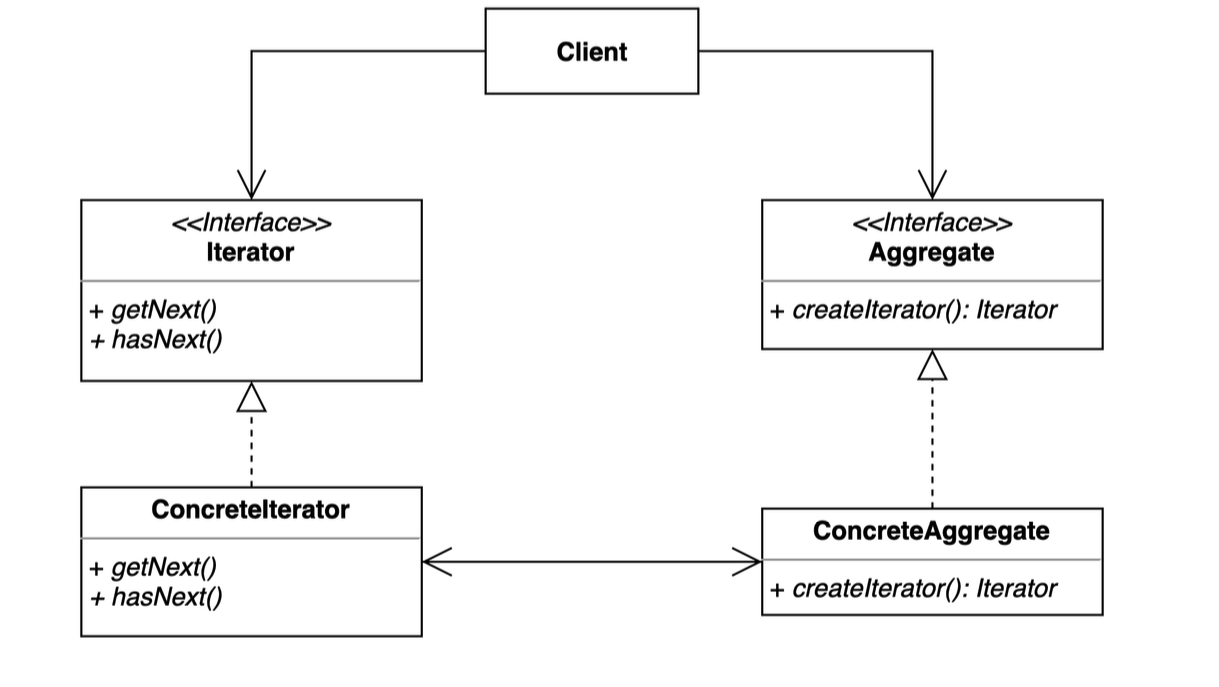Iterator Pattern
이터프리터 패턴 (Iterator Pattern)
집합 객체 내부 구조를 노출시키지 않고 순회 하는 방법을 제공 하는 패턴이다.
집합 객체를 순회하는 클라이언트 코드를 변경하지 않고도 다양한 방식으로 순회할 수 있다.
패턴 구조
- Iterator: 순회하는 인터페이스를 정의하는 클래스
- ConcreteIterator: Iterator 인터페이스를 구현하는 클래스
- Aggregate: 집합 객체를 정의하는 클래스, Iterator를 반환함
- ConcreteAggregate: Aggregate 인터페이스를 구현하는 클래스
패턴 적용 전
칠판에 post를 붙이는 프로그램을 만들어보자.
1
2
3
4
5
6
7
8
9
10
11
12
13
14
15
16
17
18
19
20
21
22
23
24
25
26
27
28
29
30
31
32
33
34
import java.time.LocalDateTime
class Post(val content: String, val createdAt: Date = LocalDateTime.now()) {
override fun toString(): String {
return "Post(content='$content', createdAt=$createdAt)"
}
}
class Board {
val posts = mutableListOf<Post>()
fun addPost(post: Post) {
posts.add(post)
}
}
fun main() {
val board = Board()
board.addPost(Post("Hello"))
board.addPost(Post("World"))
board.addPost(Post("Kotlin"))
// 게시글 출력
for (post in board.posts) {
println(post.content)
}
// 최신 글 먼저 출력
board.posts.sortByDescending { it.createdAt }.forEach {
println(it.content)
}
}
문제는 이렇게 작성된 코드는 클라이언트가 집합 객체를 직접 순회하기 때문에 집합 객체의 내부 구조가 변경되면 클라이언트 코드도 변경해야 한다.
따라서 클라이언트는 내부 구조를 모르게 하고 집합 객체를 순회할 수 있는 방법을 제공해야 한다.
패턴 적용 후
자바에는 Iterator 인터페이스가 있어서 이를 사용하면 된다.
최근 글을 순회하는 Iterator를 구현해보자. 이 후 Board에서 이 Iterator를 반환하는 메서드를 추가한다.
1
2
3
4
5
6
7
8
9
10
11
12
13
14
15
16
17
18
19
20
21
22
23
24
25
26
27
28
29
class RecentPostIterator(board: Board) : Iterator<Post> {
private val internalIterator: Iterator<Post> = board.posts.sortedByDescending { it.createdAt }.iterator()
override fun hasNext(): Boolean {
return this.internalIterator.hasNext()
}
override fun next(): Post {
return this.internalIterator.next()
}
}
class Board{
val posts = mutableListOf<Post>()
fun addPost(post: Post) {
posts.add(post)
}
fun recentPosts(): Iterator<Post> {
return RecentPostIterator(this)
}
fun getRecentPostIterator() = RecentPostIterator(this)
}
이제 클라이언트 코드는 집합 객체의 내부 구조를 알 필요 없이 집합 객체를 순회할 수 있다.
1
2
3
4
5
6
7
8
9
10
11
12
13
14
fun main(){
val board = Board()
board.addPost(Post("Hello"))
board.addPost(Post("World"))
board.addPost(Post("Kotlin"))
val recentPostIterator = board.getRecentPostIterator()
while(recentPostIterator.hasNext()){
println(recentPostIterator.next())
}
}
장단점
장점
Reference
- 코딩으로 학습하는 GoF의 디자인 패턴 - 백기선
This post is licensed under CC BY 4.0 by the author.
